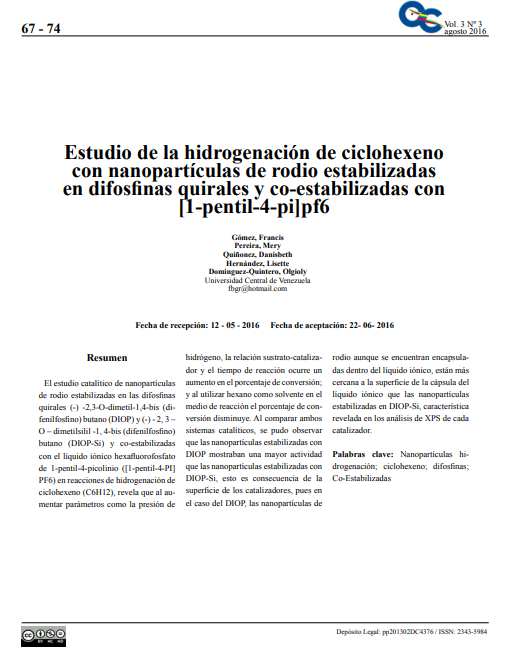Study of hydrogenation of cyclohexen with rodium nanoparticles stabilized in chiral diphosphins and co-stabilized with [1-pentil-4-pi]pf
Keywords:
cyclohexene, Nanoparticles hydrogenation, diphosphines, Co-StabilizedAbstract
The catalytic study of rhodium nanoparticles stabilized in chiral diphosphines (-)-2,3-O-dimethyl-1,4-bis (diphenylphosphine) butane (DIOP) and (-)-2,3-O-dimethylsilyl-1 4-bis(diphenylphosphine) butane (DIOP-Si) and co-stabilized with the 1-pentyl-4-pycolinium ([1-pentyl-4-PI]PF6) ionic liquid hexafluorophosphate in cyclohexen (C6H12) hydrogenation reactions, reveals that by increasing parameters such as hydrogen pressure, substrate-catalyst ratio and reaction time there is an increase in the conversion rate; and by using hexane as a solvent in the reaction medium the conversion rate decreases. When comparing both catalytic systems, it could be observed that the DIOP-stabilized nanoparticles showed a higher activity than the DIOP-Si stabilized nanoparticles, this is a consequence of the surface of the catalysts, because in the case of DIOP, the rhodium nanoparticles, although they are encapsulated inside the ionic liquid, are closer to the surface of the ionic liquid capsule than the DIOP-Si stabilized nanoparticles, a characteristic revealed in the XPS analysis of each catalyst.
Downloads
References
N. Yan, C. Xiao, Y. Kou, Coordination Chemistry Reviews. 254, 1179–1218, (2010).
D. Han, X. Li, H. Zhang, Z. Liu, C. Li, Journal of Catalysis. 243. (2006).
Christian P. Mehnert, Chem. Eur. J. 11, 50–56, (2005). E. Redel, J. Krämer, R. Thomann, C. Janiak, Journal of Organometallic Chemistry.694, 1069–1075, (2009).
L. Bastien, A. Nowicki, Bourbigou, Adv. Synth.Catal. 350, 153-159, (2008).
Mukund Ghavre, Saibh Morrissey and Nicholas Gathergood. Ionic Liquid: Applications and perspectives. Cap. 15. Hydrogenation in Ionic Liquids. 331-392.(2011).
Paul J. Dyson, Gábor Laurenczy, C. André Ohlin, James Vallance, Thomas Welton. Chem. Commun, 2418–2419, (2003).

Downloads
Published
How to Cite
Issue
Section
License

This work is licensed under a Creative Commons Attribution-NoDerivatives 4.0 International License.







